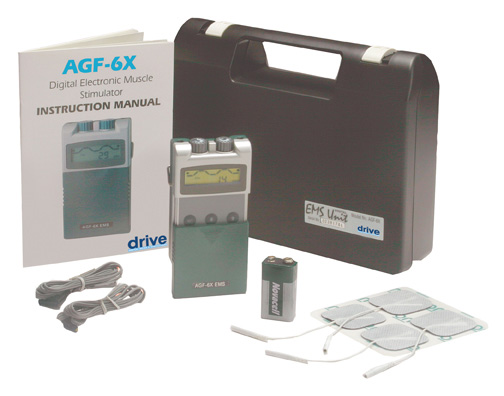Neuromuscular Electrical Stimulation (NMES / EMS)

Neuromuscular Electrical Stimulation (NMES) also known as Electrical Muscle Stimulation (EMS) is the introduction of an electrical current or impulses through the skin via electrodes to stimulate nerve and muscle tissue to improve motor performance. The electrical activation of the muscles provides an active exercise to select muscles that an individual is unable or hesitant to contract voluntarily. NMES is used to:
- Strengthen muscles that have been damaged, weakened or atrophied by being immobilized for an extended period by activating type II fast twitch muscle fibers.
- Facilitate motor unit recruitment during activity as part of muscle re-education therapy.
- Maintain or improve joint range of motion by the repetitious movement of the limb through the desired ROM.
- Decrease muscle spasticity through activation of spastic muscle.
- Promotion of peripheral circulation to involved tissues by activation of the venous muscle pump thereby enhancing oxygen and nutrient delivery while reducing swelling to the area.
|
Indication for Use |
Rationale for Use |
|
Restore a muscle’s force generating capacity following surgery or injury |
Provides muscle stimulation to cause the muscle to contract to assist in strengthening the muscle when used jointly with therapeutic exercises
|
|
Reduce muscle inhibition secondarily to joint pain and effusion |
By selectively recruiting large type II muscle fibers it overcomes the “inhibition” to recruitment caused by joint pain and swelling |
|
Help maintain muscle integrity in injuries affecting the peripheral nerves |
The repetitive contraction of the musculature promotes enhanced blood flow for better nutrition, decreased fibrotic changes in the muscle |
|
Provide treatment of osteoarthritis and rheumatoid arthritis |
NMES therapy has shown to decrease associated pain, movement fatigue, and joint stiffness |
|
Stroke treatment |
NMES therapy has shown to increase function, speed of movement, dexterity, and range of motion |
|
Treatment of children with cerebral palsy |
When coupled with dynamic bracing, NMES has shown to improve grip and pinch strength while helping to correct wrist and finger deformity |
|
Treatment for patients with Chronic Obstructive Pulmonary Disorder |
NMES therapy has shown to increase muscle and respiratory function providing increased oxygen uptake, exercise tolerance without dyspnea and leg muscle fatigue |
|
Contraindications/Precautions for Use of NMES/EMS |
|
|
Contraindication |
Rationale |
|
Use on body areas where movement could compromise healing (unfixated fracture, sutured nerves or tendons) |
Movement from muscular contraction may disrupt healing |
|
Patients who have a demand-inhibited cardiac pacemaker |
The electrical signals from the NMES/EMS device may mimic normal cardiac activity and interfere with the pacemaker |
|
Directly over superficial metal implants |
Potential for current to concentrate in the metal causing it to heat up |
|
Directly over open wounds or active bleeding areas |
Current concentrates in wound and may impair healing |
|
Applied over the uterus |
The effects of NMES/EMS on fetal development has not been determined |
|
Malignancies in the area being treated |
Increased blood flow may result in the spread of cancer cells |
|
Placed over the laryngeal and pharyngeal muscles |
May interrupt normal function |
ProHealthcareProducts.com sells EMS devices from Drive Medical, Baseline, Mettler, and other quality manufacturers.




